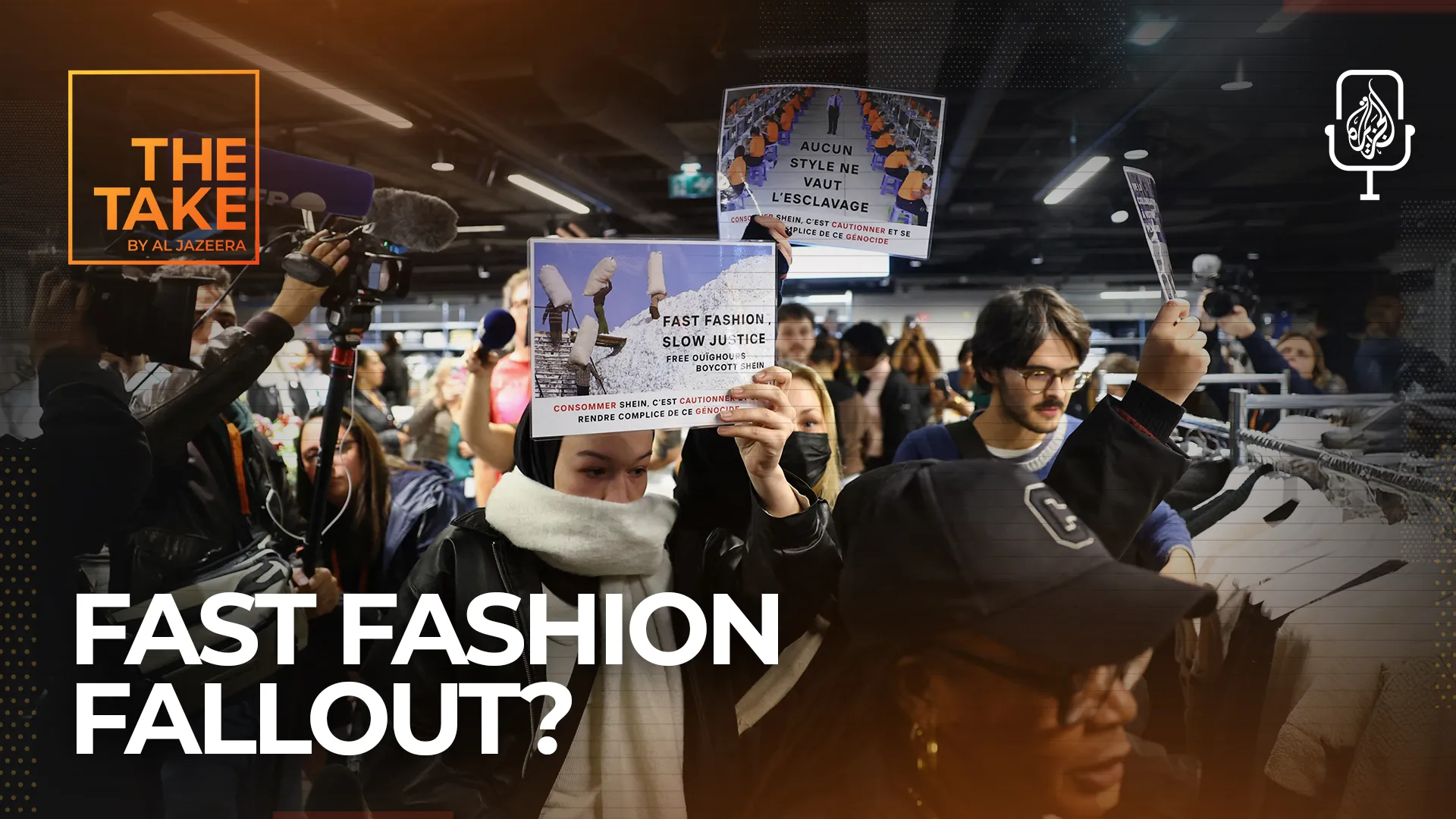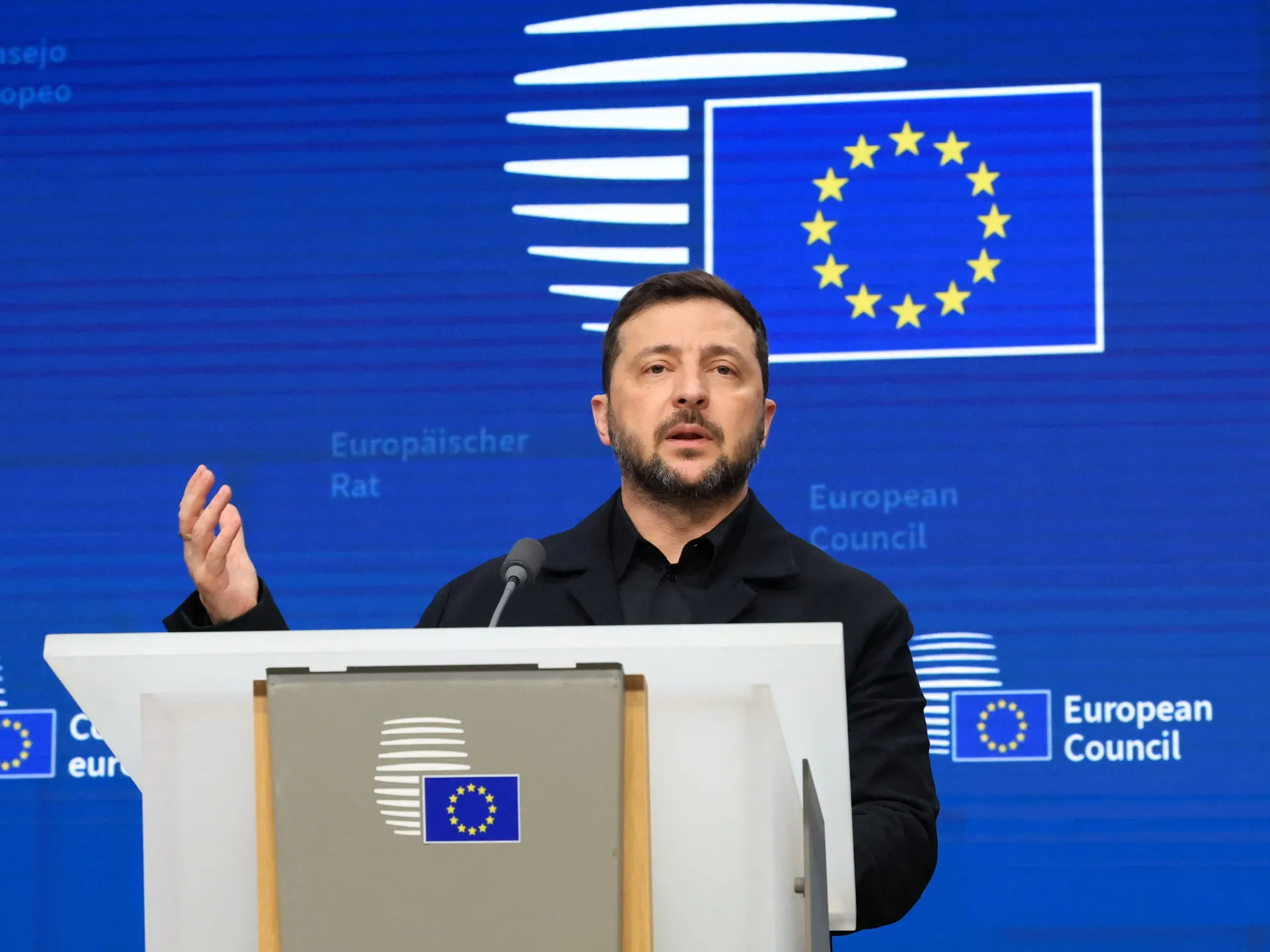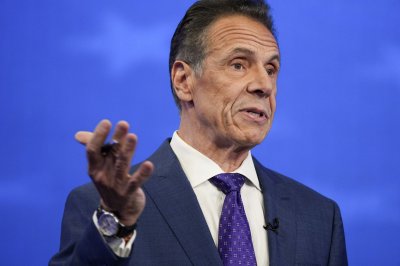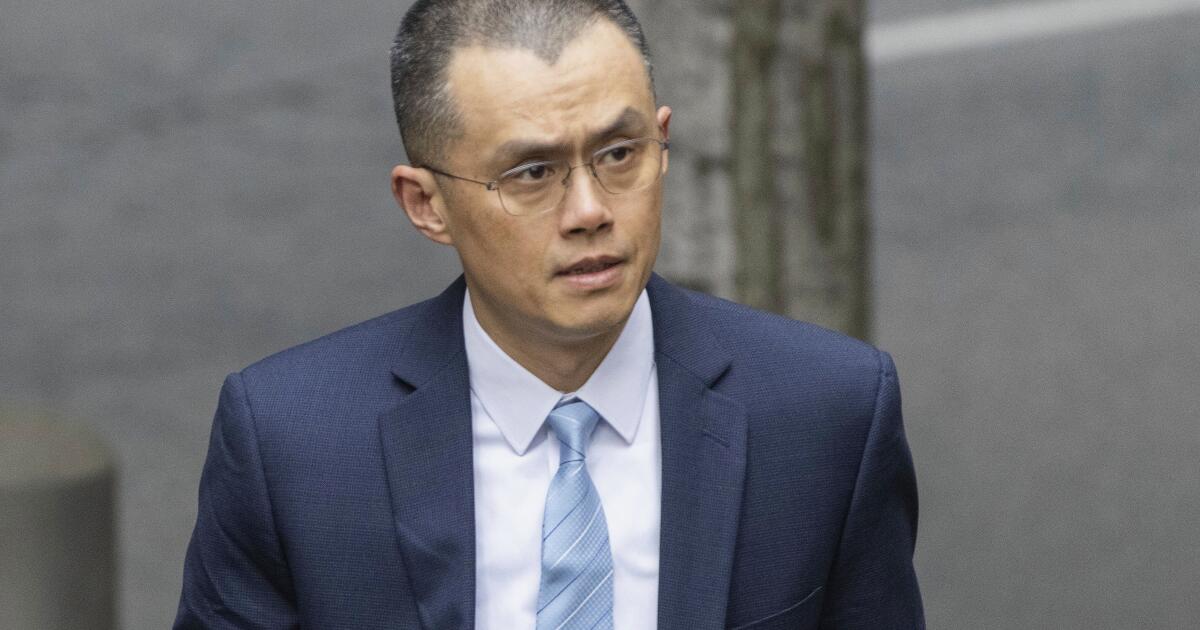Colombia’s Gustavo Petro dismisses threatened US aid cuts as ‘nothing’ | International Trade News
Petro, however, did acknowledge that a disruption in the two countries’ military cooperation could have serious consequences.
Published On 23 Oct 2025
Colombia’s President Gustavo Petro has indicated that a suspension of aid from the United States would mean little to his country, but that changes to military funding could have an effect.
“What happens if they take away aid? In my opinion, nothing,” Petro told journalists on Thursday, adding that aid funding often moved through US agencies and employed Americans.
Recommended Stories
list of 3 itemsend of list
But a cut to military cooperation would matter, he added.
“Now, in military aid, we would have some problems,” Petro said, adding that the loss of US helicopters would have the gravest impact.
US President Donald Trump had threatened over the weekend to raise tariffs on Colombia and said on Wednesday that all funding to the country has been halted.
Colombia was once among the largest recipients of US aid in the Western Hemisphere, but the flow of money was suddenly curtailed this year by the shuttering of USAID, the government’s humanitarian assistance arm. Military cooperation has continued.
The Trump administration has already “decertified” Colombia’s efforts to fight drug trafficking, paving the way for potential further cuts, but some US military personnel remain in Colombia, and the two countries continue to share intelligence.
Petro has objected to the US military’s strikes against vessels in the Caribbean, which have killed dozens of people and inflamed tensions in the region. Many legal experts and human rights activists have also condemned the actions.
Trump has responded by calling Petro an “illegal drug leader” and a “bad guy” – language Petro’s government says is offensive.
Petro has recalled his government’s ambassador from Washington, DC, but he nevertheless met with the US’s charge d’affaires in Bogota late on Sunday.
Although Trump has not announced any additional tariffs on top of the 10-percent rate already assessed on Colombian goods, he said on Wednesday he may take serious action against the country.
Petro said Trump is unlikely to put tariffs on oil and coal exports, which represent 60 percent of Colombia’s exports to the US, while the effect of tariffs on other industries could be mitigated by seeking alternative markets.
An increase in tariffs would flip a long-established US policy stance that free trade can make legitimate exports more attractive than drug trafficking, and analysts say more duties could eventually bolster drug trafficking.
Although his government has struggled to take control of major hubs for rebel and criminal activity, Petro said it has made record seizures of 2,800 metric tonnes of cocaine in three years, partly through increased efforts at Pacific ports where container ships are used for smuggling.
He also repeated an accusation that Trump’s actions are intended to boost the far right in Colombia in next year’s legislative and presidential elections.
EU leaders delay decision on using frozen Russian funds to aid Ukraine | Russia-Ukraine war News
EU leaders had hoped to agree on a plan to fund a loan of 140 billion euros to bolster Ukraine.
Published On 23 Oct 2025
Leaders across the European Union have agreed to help Ukraine fund its fight against Russia’s invasion, but stopped short of approving a plan that would draw from frozen Russian assets to do so, after Belgium raised objections.
EU leaders met in Brussels on Thursday to discuss Ukraine’s “pressing financial needs” for the next two years. Many leaders had hoped the talks would clear the way for a so-called “reparation loan”, which would use frozen Russian assets held by the Belgian financial institution Euroclear to fund a loan of 140 billion euros ($163.3bn) for Ukraine.
Recommended Stories
list of 3 itemsend of list
The EU froze about 200 billion euros ($232.4bn) of Russian central bank assets after the country launched its full-scale invasion of Ukraine in 2022. In order to use the assets to fund Ukraine’s war effort, the European Commission, the EU’s executive, has floated a complex financial manoeuvre that involves the EU borrowing matured funds from Euroclear.
That money would then, in turn, be loaned to Ukraine, on the understanding that Kyiv would only repay the loan if Russia pays reparations.
The scheme would be “fully guaranteed” by the EU’s 27 member states – who would have to ensure repayment themselves to Euroclear if they eventually decided Russia could reclaim the assets without paying reparations. Belgium, the home of Euroclear, objected to this plan on Thursday, with Prime Minister Bart De Wever calling its legality into question.
Russia has described the idea as an illegal seizure of property and warned of retaliation.
Following Thursday’s political wrangling, a text approved by all the leaders – except Hungary’s Prime Minister Viktor Orban – was watered down from previous drafts to call for “options for financial support based on an assessment of Ukraine’s financing needs.” Those options will be presented to European leaders at their next summit in December.
“Russia’s assets should remain immobilised until Russia ceases its war of aggression against Ukraine and compensates it for the damage caused by its war,” the declaration added.
Earlier, Ukrainian President Volodymyr Zelenskyy, a guest at the summit, had urged a quick passage of the plan for the loan.
“Anyone who delays the decision on the full use of frozen Russian assets is not only limiting our defence, but also slowing down the EU’s own progress,” he told the EU leaders, saying Kyiv would use a significant part of the funds to buy European weapons.
Earlier, the EU adopted a new round of sweeping sanctions against Russian energy exports on Thursday, as well, banning liquefied natural gas imports.
The move followed United States President Donald Trump’s announcement on Wednesday that Russia’s two biggest oil companies would face US sanctions.
Russian President Vladimir Putin on Thursday struck a defiant tone over the sanctions, saying they were an “unfriendly act”, and that Russia would not bend under pressure.
Tess Daly and Claudia Winkleman’s Strictly Come Dancing female replacements revealed
It’s the end of the Strictly road for Tess Daly and Claudia Winkleman, who announced they’ve quit the BBC show – but who is set to take over presenting duties?
With Tess Daly and Claudia Winkleman announcing they are quitting Strictly Come Dancing when this series ends, tongues are wagging about who will replace the presenting duo.
And already bookies have been placing their bets on who will land the lucrative gig after BBC bosses have reportedly vowed that the show must go on after 21 years on air.
Fleur East, who already presents Strictly spin-off show It Takes Two has been given odds of 2/1 – and as that’s how Claudia went on to get the main gig when she took over presenting duties from the late, great Bruce Forsyth, it would make sense she would be considered for the job.
Her co-presenter Janette Manrara is also in the running with odds of 3/1. While former It Takes Two presenter Rylan Clark and TV and radio host Roman Kemp are next in line. Zoe Ball, Holly Willoughby and Hannah Waddingham are more big names being put in the frame.
READ MORE: Strictly cast ‘blindsided’ by Tess Daly and Claudia Winkleman’s double exit
Former celebrity contestants, such as documentary maker Stacey Dooley, ex-England footballer turned pundit Alex Scott, This Morning host Alison Hammond and ex-eastEnders star Rose Ayling-Ellis have also been put in the running, according to odds from Gambling.com.
While he’s not mentioned in the odds just yet, Robbie Williams appears to have thrown his hat in the ring for the top job.
The 51-year-old Let Me Entertain You singer took to X to tell his 2.3 million followers: “Just got a rather fancy phone call about a very glittery dance floor job. Apparently, sequins and tuxedos might be in my future. Stay tuned,” followed by a wink face emoji.
A source told The Sun: “At this stage it’s all to play for and there isn’t any kind of heir apparent – though there are some obvious stars who’d be possibilities.
“What is more certain is the fact that execs are expected to opt for two more women, because the Beeb value the symbolism of an all-female presenting team on their biggest Saturday night show.
“But one element likely to play a big part is diversity because, as terrific as it is having two women hosting Strictly, they are also two middle-aged white people. This was a show created 21 years ago and now has to consider what it should look and feel like from 2026 onwards.”
The announcement has come at a good time for Claudia, who is one of TV’s most in demand presenters at the moment. She is currently enjoying huge success with BBC game show The Traitors and its celebrity version, which is airing at the moment.
She’s also landed another series of Channel 4 talent show The Piano. Both shows are said to be perfect for Claudia as “it’s lucrative and fun gig… but it also doesn’t eat into her life too much.”
With both shows only taking a few weeks to film, it will free up more time to spend with her family, including her husband Kris Thykier and their three kids. This is in comparison to Strictly, which “basically takes over her life for four months at a time”.
Tess and Claudia’s last show will be when the final of the current series airs on Saturday, December 20. But they will both in a special episode that will be shown on Christmas Day.
It’s been 21 years with 56-year-old Tess at the helm. Her former co-host was the late great Bruce Forsyth, who died in 2017 at the age of 89. Claudia, 53, who formerly presented Strictly spin-off show It Takes Two, stepped in in 2014 and has been Tess’ co-host for the past 11 years.
READ MORE: Clarkson’s Farm fans can get Jeremy Clarkson’s Hawkstone Beer advent calendar under £100
Follow Mirror Celebs on TikTok , Snapchat , Instagram , Twitter , Facebook , YouTube and Threads
What is the U.S. National Debt, and How Is It Paid?

The U.S. national debt just cleared a record $38 trillion—more than the annual output of China, Japan, Germany, the U.K., and India combined. That’s also roughly $111,000 per American.
The government will pay about $1.12 trillion in interest this fiscal year alone—roughly 13.5% of every federal dollar spent—then roll maturing debt into a steady stream of new Treasury securities.
While the debt has grown steadily over decades, warning lights are flashing brighter than ever: in May 2025, Moody’s stripped Washington of its last triple-A rating, bluntly warning that successive administrations have failed to rein in spiraling deficits.
It is the first time that all three major agencies—S&P (2011), Fitch (2023), and now Moody’s—rate America’s debt below the top tier. If investor confidence wavers, borrowing costs would climb just as trillions in Treasuries hit a “maturity wall” in 2026, testing demand on a scale never seen before.
Key Takeaways
- The U.S. national debt is spiraling ever higher.
- Roughly 80% of the debt consists of U.S. Treasurys owned by investors worldwide; the rest is intragovernmental IOUs owed to programs like Social Security.
- Treasury bonds keep the government solvent via weekly auctions.
- Interest payments alone already eat up 13.5% of all federal spending and topped $1 trillion in 2025.
How the Debt Is Structured—And Its Size
The government takes on debt to cover the gap between what it spends and what it collects in taxes—so it can keep funding programs, services, and investments even when current revenues fall short.
The U.S. national debt is a mix of government bonds that trade daily and non-marketable securities that sit exclusively on federal ledgers. This “intragovernmental” debt is money owed by one arm of the government to another—mostly for programs like Social Security and Medicare.
War spending drove early leaps in the debt, from $75 million after the Revolution to upwards of $3 billion after the Civil War. However, modern surges following the Great Recession pushed the debt-to-GDP ratio above 100% in 2013, and the COVID-19 stimulus to more than 120% today.
Unlike households, which must pay off their debts or risk bankruptcy, the federal government can roll debt indefinitely. Washington can raise taxes and, through the Fed, create more dollars. That is one reason U.S. Treasurys remain the closest thing to a “risk-free” asset and why Washington can keep borrowing year after year.
How the Government Pays Its Debt
In effect, the Treasury acts like a giant bond-fund manager: it pays out interest from current tax receipts, then issues fresh bonds to replace those that mature. This process involves regular auctions where Treasury securities are sold to investors, providing the government with the necessary funds to cover expenditures.
Foreign investors still hold about $9 trillion, led by Japan ($1.15 trillion), the U.K. ($899 billion), and China ($730 billion). Domestic pension funds and mutual funds own a growing share.
Debt Ceilings and Future Pressures
Despite mounting debt, Congress has raised the debt ceiling 78 times since 1960, using “extraordinary measures” to avoid default when the cap is reached.
There have, of course, been efforts to reduce the size of the debt, but these have often been undermined by political gridlock, unrealistic assumptions, or voter-friendly policies. Elon Musk’s so-called Department of Government Efficiency (DOGE) initially claimed $160+ billion in savings, but watchdogs say it simply shifted or delayed costs and cost taxpayers billions instead.
Meanwhile, annual net-interest outlays are expected to reach $1.8 trillion by 2035, as President Trump’s recent budget proposal, dubbed the “Big, Beautiful Bill,” is projected to add $3+ trillion to the national debt over the next decade, with further tax cuts increasing the burden by another $3.8 trillion.
The Bottom Line
The U.S. doesn’t so much “pay off” its national debt as manages it, relying on continued investor confidence, a flexible debt ceiling, and economic growth. Credit downgrades and rising costs, however. highlight growing risks—but the depth of Treasury markets and America’s unique fiscal standing still give policymakers room to act for now—if they choose to.
Chelsea Clinton is pregnant again; Hillary and Bill Clinton ‘couldn’t be happier’
Chelsea Clinton is already running for a second term — as a mom!
“Next summer, Charlotte is going to be a big sister! Feeling very blessed & grateful this holiday season,” the former first daughter said Monday on Twitter. She and husband Marc Mezvinsky had their first child, Charlotte Clinton Mezvinsky, in late September 2014.
The announcement featured a picture of Charlotte eyeballing a book titled “Big Sisters Are the Best.” (Perhaps the little one’s next read will be her mom’s book “It’s Your World: Get Informed, Get Inspired & Get Going”? OK, we’ll give her some time …)
Grandparents Bill and Hillary Clinton were quick to jump in with official congratulations.
Follow Christie D’Zurilla on Twitter @theCDZ and Google+. Follow the Ministry of Gossip on Twitter @LATcelebs.
Follow Christie D’Zurilla on Twitter @theCDZ and Google+. Follow the Ministry of Gossip on Twitter @LATcelebs.
Celtic 'not quite a Ferrari but a Range Rover Sport'
Manager Brendan Rodgers is pleased with the way his Celtic players bounced back from their defeat at Dundee, with victory over Sturm Graz.
Source link
EV maker Rivian to cut 4.5% of its workforce

Oct. 23 (UPI) — All-electric vehicle maker Rivian Automotive has announced it is laying off 4.5% of its workforce amid mounting market pressures, the company said Thursday.
In a memo sent to employees, company founder and CEO RJ Scaringe said the cuts involve restructuring of its marketing, vehicle operations, sales and delivery and mobile teams, according to CNBC.
“These were not changes that were made lightly,” Scaringe said in the memo. “With the changing operating backdrop, we had to rethink how we are scaling out go-to-market- functions. The news is challenging to hear, and the hard work and contributions of the team members who are leaving are greatly appreciated.”
Rivian ended 2024 with just under 15,000 employees.
Scarigne’s memo did not say exactly how many employees would be let go, but according to The Wall Street Journal, which first reported the plan, the layoffs would affect more than 600 employees.
Rivian and other elective vehicle makers are facing difficult sales and marketing conditions following the end of a $7,500 dollar tax credit for EV purchases in the new federal budget.
Demand has also been lower than expected for Rivian amid regulatory issues. The automaker also lacks new products until next year and faces a cash shortage. It lost $1.1 billion during the second quarter.
This is the latest in a series of layoffs. Rivian furloughed between 100 and 150 workers in its commercial and manufacturing teams between September 2024 and June.
Rivian is scheduled to release at least 150,000 R2 SUVs in 2026, which will be more widely available to consumers than previous models.
The company also recently started construction on its third manufacturing facility outside of Atlanta, where it plans to build the R2 and other models.
The company has struggled to maintain a sales pace with its current lineup of vehicles. Its sales are projected to drop by 16% in 2025 compared to last year.
Is Trump losing patience with Putin over the Ukraine war? | Donald Trump
United States President Donald Trump sanctions Russia’s two biggest oil companies – after scrapping a summit with President Vladimir Putin on the Ukraine war.
The European Union has also announced new measures targeting Russian oil and assets.
Will they bring an end to the war any closer?
Presenter: Bernard Smith
Guests:
Anatol Lieven – Director of the Eurasia programme at the Quincy Institute for Responsible Statecraft
Steven Erlanger – Chief Diplomatic Correspondent for Europe at The New York Times
Chris Weafer – CEO of Macro-Advisory, a strategic consultancy focused on Russia and Eurasia
Published On 23 Oct 2025
Mel B reveals she’s been kicked out of Spice Girls group chat AGAIN by furious bandmates
MEL B has admitted she’s been kicked out of the Spice Girls WhatsApp group chat in a new social media post.
Scary Spice says she’s been removed from the girl group’s chat after suggesting that they go on tour again.
She announced the ordeal in a TikTok video, posing up a storm in a striking number while strutting in a pair of heels.
“Me on my way back to spice group chat after being kicked out for saying we are going on tour… again,” she wrote on-screen.
Mel, 50, made sure to use the hashtag “letmebackin” while tagging the Spice Girls.
Paired up to the tune One Step At A Time, the post has sparked comments from followers calling for another tour.
“Just make it happen Mel we’re all bored,” one commented.
A second said, “Tell Victoria she doesn’t even need to sing just stand on stage and serve some little black dress looks.”
While a third wrote: “Pls do a Vegas residency. I would go multiple.”
A fourth commented: “Victoria said, in her Netflix doc, she would be interested in performing at the Sphere in Vegas I WOULD PAY ALL THE MONEY.
“I saw Backstreet Boys and the show was next level.”
A fifth added: “The biggest regret of my life, honestly, was not seeing you girls when you performed in Vancouver.
“I was in high-school and all my friends went and my parents couldn’t afford it.
“I’m an adult now with my own money! pleaseeeeeeeeeeeee @Victoria Beckham.”
It’s not the first time that Mel’s been removed from the Spice Girls group chat.
Last year while appearing on ITV’s This Morning, she admitted she was always being pulled out of the band’s WhatsApp.
“Yeah I’m always getting…that always happens to me,” she told Alison.
“Because I say things, you know I get so excited when it comes to Spice Girls, because it is 30 years and we’ve got a lot to celebrate.
“The fact that we’re all still healthy and living life and all talking still. It’s nice.”
“I can’t say anything else to get myself kicked out. Don’t try Alison.”
Trump calls off San Francisco ‘surge,’ but East Bay braces for action as protests erupt
OAKLAND — President Trump said Thursday that he had called off a planned federal “surge” into San Francisco after speaking with Mayor Daniel Lurie and other city leaders — a detente that officials and activists in the East Bay said they were not welcomed into and viewed with some suspicion, as potentially enlarging the target on their own communities.
Trump’s announcement came amid protests at the entrance to the U.S. Coast Guard base across the bay in Alameda County, where the Department of Homeland Security has begun staging additional forces. It followed a similar announcement by Lurie, who said he had told Trump during a phone call late Wednesday that San Francisco is “on the rise” and that “having the military and militarized immigration enforcement in our city will hinder our recovery.”
Lurie said Trump agreed to call off any federal deployment to the city, and that Homeland Security Secretary Kristi Noem — who is in charge of federal immigration forces — had “reaffirmed that direction” in a conversation with him Thursday morning.
Trump said on social media that his administration had been planning a “surge” in San Francisco beginning Saturday, but that Lurie had asked him “very nicely” to “give him a chance to see if he can turn it around,” and that other “friends” of Trump’s in the city had asked him to call it off because they believe Lurie is “making substantial progress.”
Trump said he told Lurie that he was “making a mistake, because we can do it much faster, and remove the criminals that the Law does not permit him to remove,” but that he had ultimately agreed to pause the surge — in part because Lurie has the support of prominent business leaders Jensen Huang of Nvidia and Marc Benioff of Salesforce.
During a Thursday morning briefing less than an hour after Trump’s post, Oakland Mayor Barbara Lee and other East Bay leaders said they had “no information” about such a stand-down in their communities, and were still bracing for increased federal immigration raids given the staging of forces at nearby Coast Guard Island, which is in the waters between Alameda and Oakland.
“The federal administration, of course, has escalated its rhetoric and its enforcement posture in the Bay Area. We know that Border Patrol agents are being stationed on Coast Guard Island,” Lee said. “But … we are fully prepared. We’re monitoring developments closely and we’ll keep our residents informed if there are any confirmed changes. Oakland is and will continue to be a welcoming city for our immigrants and our refugees.”
The Department of Homeland Security defended the deployment of its agents to the region, saying they would be “targeting the worst of the worst criminal illegal aliens — including murderers, rapists, gang members, pedophiles, and terrorists.”
Alameda County Dist. Atty. Ursula Jones Dickson said the staging of immigration forces in the East Bay was part of an established Trump administration “playbook” to rile up communities with immigration actions and then use any unrest to justify further force — and called on East Bay residents not to fall for it.
“We know that they’re baiting Oakland, and that’s why San Francisco, all of a sudden, is off the table,” Jones Dickson said. “So I’m not going to be quiet about what we know is coming. We know that their expectation is that Oakland is going to do something to cause them to make us the example.”
Lourdes Martinez, co-director of the immigrant rights program at Centro Legal de la Raza, said communities are understandably scared given recent legal rulings that federal immigration agents can stop people based on factors such as the color of their skin, the language they are speaking and the job sectors they work in — and organizers expect more such stops given the latest deployments.
She called on immigrants and others to protect themselves by readying documentation and making sure that they and their families are familiar with their rights to remain silent and to have an attorney — and how to contact legal advocacy groups in case of trouble. She also urged community members to report any detentions, to “make sure that nobody disappears.”
“We know this is an uncertain and stressful time. However, this is a moment of unity and power, not panic,” she said.
Shortly after Lee’s event, about 40 protesters gathered near a bridge leading to Coast Guard Island.
Music was blasting. One person wore a blow-up animal costume, a trend that gained momentum amid similar protests in Portland recently. Coast Guard members in tactical gear stood in a line across from protesters who screamed at them.
“We knew there was going to be [an immigration enforcement] presence here and we wanted to disrupt in a peaceful way — to make it harder for them to abduct people,” said Lindsey Swanson, 32, a financial planner who lives in Oakland.
Swanson and others said they believed immigration enforcement would also ramp up in San Francisco, despite Trump and Lurie’s morning assurances, and would continue in the East Bay regardless.
“There’s East Bay — Oakland, Berkeley — so calling off San Francisco means nothing,” said Rachel Kim, a 28-year-old Berkeley resident who is training to become a therapist.
White House press secretary Karoline Leavitt said Thursday that Trump’s conversation with Lurie was an example of how he is willing to work with Democrats and other states to “do the right thing and clean up America’s cities.”
“He is genuinely interested in this effort to make our streets safer, to make our cities safe and clean again,” she said.
The morning events followed days of growing tensions in the Bay Area over Trump’s plans for the region, after he repeatedly suggested that he would send federal forces into San Francisco — which he called a “mess” in desperate need of help, despite data showing decreasing crime and homeless encampments and surging positive sentiment.
On Wednesday, Gov. Gavin Newsom confirmed the staging of immigration agents in the area, and suggested it was the first move in a broader effort by Trump and his administration to stoke chaos and intimidate residents in yet another liberal part of the country.
“He sends out masked men, he sends out Border Patrol, he sends out ICE, he creates anxiety and fear in the community so that he can lay claim to solving that by sending in the Guard,” Newsom said. “This is no different than the arsonist putting out the fire.”
The response echoed those of leaders and activists in other cities where immigration forces and federal troops have been deployed, including Los Angeles, Washington, D.C., Chicago and Portland. It added to an already rancorous debate around Trump’s mass deportation initiative, which he campaigned on heavily, and the role of federal forces in American cities — something the founders of the nation limited to extreme circumstances.
Central to that debate has been Trump’s repeated and unprecedented decision to repeatedly send troops into American cities without the explicit support of state or local leaders. Federal judges have been divided on that issue, though it has so far been allowed to continue in Los Angeles by the U.S. 9th Circuit Court of Appeals.
But even in the appellate court, there has been tense disagreement.
Liberal judges on the court recently called for the decision allowing the deployments to continue in Los Angeles, which was made by a three-judge panel, to be reheard before a larger, 11-judge panel. When that request was denied, several dissented Wednesday — excoriating the deployments as a clear breach of constitutional law and the separation of powers.
Judge Marsha Berzon, in a dissent joined by 10 fellow 9th Circuit judges, wrote that the smaller panel in its preliminary deference to Trump had “invited presidents, now and in the future, to deploy military troops in response to the kinds of commonplace, shortlived, domestic disturbances whose containment conventionally falls to local and federal law enforcement units.”
Times staff writer Ana Ceballos, in Washington, D.C., contributed to this report.
Why a Dodgers interpreter wears rabbit-themed boxers when Yamamoto pitches
From the hot tub in the Dodger Stadium clubhouse, Yoshinobu Yamamoto saw his interpreter on his way to take a shower.
Yamamoto called out to him.
“What are those colors?” Yamamoto asked him.
Yoshihiro Sonoda, 48, wore only a pair of boxers that depicted a rabbit with rainbow-colored lasers shooting out of its eyes.
Sonoda explained bashfully, “These are my shobu pantsu.”
For more than a year, Sonoda had worn shobu pantsu — or game underwear — for each one of Yamamoto’s starts.
Sonoda chuckled as he recalled the incident. Several weeks have passed since then, and the superstitious interpreter still wears his lucky boxers on days Yamamoto pitches.
When Yamamoto takes the mound for the Dodgers against the Toronto Blue Jays on Saturday in Game 2 of the World Series, beneath Sonoda’s team-issued sweatpants will be the rabbit and rainbow-colored lasers.
The kid is a little different.
Sonoda recalled thinking that last year on the first day of spring training. On a grass field near the players’ parking lot, he watched Yamamoto throw javelins as part of his workout routine.
When the Japanese right-hander was finished, Sonoda started collecting the projectiles.
Yamamoto stopped him.
“Please, you’re my interpreter,” he said. “You’re not my servant.”
Yamamoto picked up his javelins and carried them back to the clubhouse.
In the months that followed, Sonoda noticed how Yamamoto treated others. He wasn’t kind only to other players. He was also conscientious of the organization’s rank-and-file employees.
“He pretends he’s not watching, but he’s watching,” Sonoda said. “He seems like he’s not listening, but he’s listening.”
Every day the Dodgers are on the road, Yamamoto has Starbucks coffee delivered to the team hotel. He always orders something for Sonoda.
“I think Yamamoto is quite the gentleman, quite the high character,” manager Dave Roberts said. “He treats everyone from Hiro to myself to all the support staff with the highest of respect.”
Two days into the job as Yamamoto’s interpreter, Sonoda wanted to resign.
A former collegiate judo standout in Japan, Sonoda spent the previous two decades working in the entertainment industry as a lighting engineer, his credits including “Men in Black,” “The Amazing Spider-Man,” “Succession” and “Nurse Jackie.”
He had no previous experience as an interpreter and was by no means a baseball expert. He was apart from his wife, who remained in her native Texas.
“I don’t want to quit, but I can’t do this,” Sonoda told traveling secretary Scott Akasaki.
Akasaki, who was once an interpreter for Hideo Nomo, asked Sonoda to reconsider.
Dodgers pitcher Yoshinobu Yamamoto, left, speaks to reporters with his interpreter, Yoshihiro Sonoda, in a press conference before Game 1 of the 2024 NLDS against the San Diego Padres.
(Ashley Landis / Associated Press)
“You can learn about baseball if you study it,” Sonoda recalled being told by Akasaki. “But Yoshinobu chose you for a reason, and that’s something no other person has.”
Sonoda never shared his insecurities with Yamamoto, instead throwing himself head first into his work. He was taught how to interpret ball-tracking data by assistant pitching coach Connor McGuiness and performance science manager Tyler Duncan. He consulted with veteran interpreters, including Shingo Horie of the San Diego Padres and Hiro Fujiwara of the New York Mets.
Last year at World Series media day, Yamamoto was asked about Sonoda.
“We were both rookies this year,” Yamamoto said. “Sonoda-san especially, he came from a different industry and I would think he endured a lot of hardship. But he didn’t let on about that being the case.”
Standing by Yamamoto’s side, Sonoda fought back tears.
Sonoda has a small notebook in which he tracks every pitch thrown by Yamamoto. In a night game in Baltimore last month, Sonoda took notes as usual, jotting down pitches types and their locations.
Yamamoto carried a no-hitter into the ninth inning.
When there were two outs, Sonoda had Shohei Ohtani on one side of him and trainer Yosuke Nakajima on the other.
Sonoda stopped taking notes.
“I thought I should prepare to celebrate,” he said.
Jackson Holliday homered, and the no-hitter was gone.
Sonoda blamed himself.
“If only I had taken notes on that at-bat …” he said.

Sonoda was a significantly better interpreter this season than he was last season. On his commutes to Dodger Stadium, he listens to audio of Horie interpreting for Yu Darvish or Fujiwara for Kodai Senga.
Yamamoto noticed.
“His efforts in the shadows have been to where I can feel them,” Yamamoto said. “He’s a very pure and straightforward person. I think he’s really wonderful.”
Last year, Sonoda received a set of national-park-themed underwear from his wife, who knew of his affinity for the outdoors. The Yellowstone Park pair featured a roaring bear, which reminded Sonoda of Yamamoto screaming on the mound. Sonoda started wearing the boxers on days Yamamoto pitched, switching to a different pair for the next start if he lost or didn’t pitch well.
A new season called for a new set of underwear, but a stretch of inadequate run support prompted Sonoda to unretire a pair he wore on the Dodgers’ World Series run last year, the ones with the rainbow-emitting rabbit.
“I’m very superstitious,” Sonoda said.
Sonoda is also grateful.
“I think there are 14 or 15 Japanese interpreters in the majors leagues,” he said. “I feel like I’m the most blessed.”
Blessed because Akasaki talked him out of resigning. Blessed because of the baseball education he received from McGuiness and Duncan. Blessed because he has mentors such as Horie and Fujiwara. And above all, blessed because he was paired with a player whom he considers as good a person as he is a pitcher, the kind of high-character individual for whom he would wear radiant underwear in the off chance it could improve his fortune.

Eric Adams endorses Cuomo in New York mayor’s race
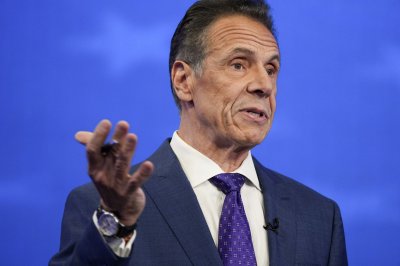
Oct. 23 (UPI) — Outgoing New York Mayor Eric Adams officially endorsed former Gov. Andrew M. Cuomo to replace him.
Adams ended his campaign for re-election in late September after a federal bribery indictment and the Campaign Finance Board’s decision to withhold millions in public matching funds. After Cuomo pressured him to leave the race, Adams called him a “snake and a liar,” The New York Times reported.
But now the two are friends again, announcing the endorsement together on a sidewalk in East Harlem. “Brothers fight,” Adams said. “But when families are attacked, brothers come together.”
On Wednesday night, Cuomo, a Democrat running as an independent, participated in the final debate of the election season, facing off against front-runner Zohran Mamdani, a Democratic Socialist running as a Democrat; and Republican Curtis Sliwa.
In an interview with The Times Thursday, Adams said that he would campaign with Cuomo in neighborhoods where the mayor is most popular and try to urge people to vote for Cuomo.
“I think that it is imperative to really wake up the Black and brown communities that have suffered from gentrification on how important this race is,” Adams said. “They have watched their rents increase in terms of gentrification and they have been disregarded in those neighborhoods, and I’m going to go to those neighborhoods and speak one on one with organizers and groups, and I’m going to walk with the governor in those neighborhoods and get them engaged.”
Mamdani released a statement after the announcement.
“Today confirms what we’ve long known: Andrew Cuomo is running for Eric Adams’s second term,” Mamdani said. “It’s no surprise to see two men who share an affinity for corruption and Trump capitulation align themselves at the behest of the billionaire class and the president himself. We are going to turn the page on the politics of big money and small ideas that these two disgraced executives embody and build a city every New Yorker can afford.”
Sliwa brushed off the endorsement at a press conference Thursday. He told reporters that the two men were “corrupt birds of a feather flocking together.”
“The guy who called Andrew Cuomo a snake is now the snake charmer,” Sliwa said. “Are you surprised by that?”
President Trump pardons Binance founder Changpeng Zhao
Liv McMahonTechnology reporter
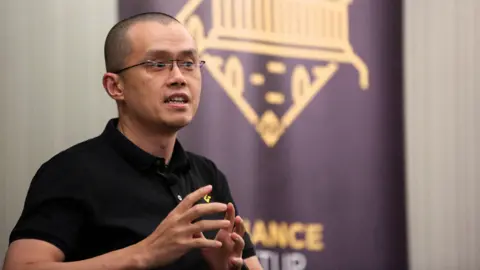 Reuters
ReutersChangpeng Zhao, founder of the world’s largest cryptocurrency exchange Binance, has been pardoned by US President Donald Trump.
Zhao, also known as “CZ”, was sentenced to four months in prison in April 2024 after pleading guilty to violating US money laundering laws.
Binance also pleaded guilty and was ordered to pay $4.3bn (£3.4bn) after a US investigation found it helped users bypass sanctions.
The pardon reignited debate over the White House embrace of cryptocurrency as the Trump family’s own investments in the industry have deepened.
White House Press Secretary Karoline Leavitt called Zhao’s prosecution under the Biden administration part of a “war on cryptocurrency”, pushing back on critics who said the pardon appeared motivated by Trump’s personal financial interests.
“This was an overly prosecuted case by the Biden administration,” she said, adding that the case had been “thoroughly reviewed”. “So the president wants to correct this overreach of the Biden administration’s misjustice and he exercised his constitutional authority to do so.”
Binance had spent nearly a year pursuing a pardon for its former boss, who completed his four-month prison sentence in September 2024, the WSJ reported on Thursday.
Its campaign came as Trump, who released his own coin shortly ahead of his inauguration in January, promised to take a friendlier approach to the industry than his predecessor.
Since then, he has loosened regulations, sought to establish a national cryptocurrency reserve and pushed to make it easier for Americans to use retirement savings to invest in digital assets.
Zhao, who stepped down as Binance chief executive in 2023, wrote on social media on Thursday that he was “deeply grateful for today’s pardon and to President Trump for upholding America’s commitment to fairness, innovation, and justice”.
The pardon lifts restrictions that had stopped Zhao from running financial ventures, but it’s not yet clear whether it changes his standing with US regulators or his ability to lead Binance directly.
In a statement Binance called the decision “incredible news”.
The exchange, which is registered in the Cayman Islands, remains the world’s most popular platform for buying and selling cryptocurrencies and other digital assets.
It did not respond to further questions about the conflict of interest claims.
Before the pardon, Zhao’s companies had partnered with firms linked to Donald Trump on new digital-currency projects including Dominari Holdings, where his sons sit on the board of advisers and which is based in Trump Tower.
The Wall Street Journal also previously reported representatives of the Trump family – which has its own crypto firm World Liberty Financial – had recently held talks with Binance.
The Trump administration previously halted a fraud case against crypto entrepreneur Justin Sun, after his investments in the Trump family’s crypto firm, World Liberty Financial.
He has also pardoned founders of the crypto exchange BitMex, who also faced charges related to money laundering, and Ross Ulbricht, founder of the Silk Road, the dark web marketplace known as a place for drug trade.
Palantir co-founder Joe Lonsdale wrote on social media that he loved Trump but the president had been “terribly advised” on pardons.
“It makes it look like massive fraud is happening around him in this area,” he said.
Senator Elizabeth Warren, a Democrat, blasted the decision in a statement as a “kind of corruption”.
Asked about the decision to pardon Zhao on Thursday, Trump appeared not to not know who he was.
“Are you talking about the crypto person?” he asked, later saying he had granted the pardon at the “request of a lot of good people”.
When US officials announced the Binance guilty plea in 2023, they said Binance and Zhao were responsible for “wilful violations” of US laws, which had threatened the financial system and national security.
“Binance turned a blind eye to its legal obligations in the pursuit of profit,” said then-Treasury Secretary Janet Yellen.
“Its wilful failures allowed money to flow to terrorists, cybercriminals, and child abusers through its platform.”
Zhao stepped down as Binance chief executive as part of the resolution of the case, writing at the time that resigning was “the right thing to do”.
“I made mistakes, and I must take responsibility,” he said.
Reporting contributed by Bernd Debussman Jr

Essay: What ‘Kiss of the Spider Woman’ can teach us about surviving fascism
When “Kiss of the Spider Woman” premiered at the Sundance Film Festival in January, it was in the shadow of President Trump’s return to office.
Just days earlier, Trump had begun his term with a wave of executive orders to expand the country’s immigration detention infrastructure, fast-track deportations, remove protections preventing Immigrations and Customs Enforcement (ICE) officials from targeting schools and churches, and a declaration that the U.S. government would recognize only two sexes.
Referencing these developments ahead of the screening in Park City, Utah, writer-director Bill Condon told the audience: “That’s a sentiment I think you’ll see the movie has a different point of view on.”

Released in theaters Oct. 10, “Kiss of the Spider Woman” is set in the final year of Argentina’s Dirty War, the violent military dictatorship that spanned from 1976-1983. The story begins in the confines of a Buenos Aires prison, where newfound cellmates Valentin Arregui Paz (Diego Luna) and Luis Molina (Tonatiuh) find they have little in common. Arregui is a principled revolutionary dedicated to his cause, while Molina is a gay, flamboyant window dresser who’s been arrested for public indecency.
Undeterred by their differences, Molina punctuates the bleak existence of their imprisonment — one marked by torture and deprivation — by recounting the plot of “The Kiss of the Spider Woman,” a fictional Golden Age musical starring his favorite actress, Ingrid Luna (Jennifer Lopez), casting himself and Arregui as her co-stars. Transported from their dreary cell to the bright, indulgent universe of the musical, their main conflicts become a quest for love and honor, rather than a fight for their basic human rights.
When Argentinian author Manuel Puig began writing the celebrated novel, “Kiss of the Spider Woman,” in 1974, it was just a year into his self-imposed exile to Mexico as his native Argentina lurched toward authoritarianism. By the time the book was released in 1976, a military junta had seized control of the government. The next seven years were marked by the forced disappearance of an estimated 20,000-30,000 people, many of whom were kidnapped and taken to clandestine detention camps to be tortured and killed. Among those targeted were artists, journalists, student activists, members of the LGBTQ+ community and anyone deemed “subversive” by the regime.
Initially banned in Argentina, Puig’s novel has been adapted and reimagined multiple times, including as an Oscar-winning film in 1985 and a Tony Award-winning musical in 1993. With each iteration, the central elements have remained unchanged. And yet, as the 2025 adaptation arrived in theaters this month, this queer, Latino-led story of two prisoners fighting the claustrophobia of life under fascism feels at once like a minor miracle, and a startling wake-up call.

Tonatiuh, left, and Diego Luna in the movie “Kiss of the Spider Woman.”
(Sundance Institute)
In the months since the film’s Sundance premiere, the parallels between the fraught political climate of 1970s Argentina and that of our present have only become more pronounced.
Under Trump, an endless stream of escalating violence from masked federal agents has become our new normal. ICE officers have been filmed apprehending people outside of immigration court; firing pepper balls, rubber bullets and tear gas at journalists, protesters and clergymen; and, earlier this month, they descended from Black Hawk helicopters, using flash-bang grenades to clear a Chicago apartment building in a militarized raid that had men, women and children zip-tied and removed from their homes. As the country’s immigrant detention population reaches record highs, widespread reports of abuse, neglect and sexual harassment, particularly against LGBTQ+ detainees, have emerged from facilities across the U.S.
Amidst these headlines are people just like Molina and Arregui — activists, artists and human beings — finding their own ways to survive and resist an increasingly paranoid and repressive government. And while Arregui’s instinct is to remain unwavering in his cause, Molina’s is to retreat into the glamorous, over-the-top world of the “Spider Woman.”
In dazzling musical numbers expertly performed by Lopez, who delivers each song and dance with all the magnetism of a true Old Hollywood icon, both the prisoners and the audience can’t help but be drawn further and further into her Technicolor web.

Jennifer Lopez and Tonatiuh in the movie “Kiss of the Spider Woman.”
(Roadside Attractions)
It might be easy to write these moments off as nothing more than a superficial distraction, as Arregui does early on, and characterize musicals as shallow and cliche. At first, Molina is happy to admit that’s why he loves them, but the truth is more complicated.
During Argentina’s dictatorship, discrimination and attacks by paramilitary groups against LGBTQ+ people became more and more frequent. Molina accepts the role society has cast him in, allowing himself to be the “monster,” the “deviant” or the “sissy” that people want him to be, while retreating mentally into the world of classic films and pop culture. For him, their beauty is a salve — an opportunity to abandon reality and cast himself in a role that doesn’t actually exist for him.
Though he never explicitly claims an identity, it’s made clear that he doesn’t just love “La Luna” — he wants to be her. And in their first feature lead role, the queer, L.A.-born actor Tonatiuh embodies all of Molina’s contradictions — his bluster, his pain, his radiance — to heart-wrenching effect.
As Molina and Arregui grow closer, the boundaries between reality and fantasy begin to melt, and their formerly rigid perceptions collapse along with them. Arregui takes on some of Molina’s idealism, and the musical he once saw as a tired cliche becomes something invaluable: a sliver of joy that can’t be taken from him. A cynic convinced of the world’s brokenness, he realizes that revolutions need hope too.
In the film’s final act, while the world around Molina hasn’t changed, he has. Still trapped within the confines of a society that is doing its best to crush him, he adopts Arregui’s integrity and realizes that he has a choice: “I learned about dignity in that most undignified place,” he says in the film. “I had always believed nothing could ever change for me, and I felt sorry for myself. But I can’t live like that now.”
Like the film within the film, “Kiss of the Spider Woman” isn’t an escape. It’s a lifeline — and a reminder that, even in the darkest of times, art has the power to transport us, sustain us and embolden us to be brave.
California welfare recipients withdrew $1.8 million at casino ATMs over eight months
California welfare recipients using state-issued debit cards withdrew more than $1.8 million in taxpayer cash on casino floors between October 2009 and last month, state officials said Thursday.
Gov. Arnold Schwarzenegger issued an executive order requiring welfare recipients to promise they will use cash benefits only to “meet the basic subsistence needs” of their families. The order also gave the state Department of Social Services seven days to produce a plan to reduce other types of “waste, fraud and abuse” in the welfare program.
The moves came after The Times reported Wednesday that officials at the department failed to notice for years that welfare recipients could use the state-issued cards to withdraw taxpayer cash at more than half of the tribal casinos and state-licensed poker rooms in California. The state initiated the debit card program in 2002.
Casino withdrawals, which represented far less than 1% of total welfare spending during the eight months for which the department released data, averaged just over $227,392 a month.
Schwarzenegger has already ordered the vendor that runs the state welfare system’s ATM network to prohibit the cards from working at casino machines. Republican lawmakers are now calling on the administration to track down the people who withdrew cash at gaming centers and recover the money.
“I’d say that $227,000 per month is an astounding waste of taxpayer dollars,” said Seth Unger, spokesman for Assembly Republican Leader Martin Garrick of Solana Beach. “To me it is absolutely clear that the department failed in its duty to provide oversight. We should explore all options to get the money back.”
The electronic benefit transfer cards allow welfare recipients to access two accounts: cash offered through the Temporary Assistance for Needy Families program and an electronic version of food stamps, which comes with strict rules governing how the money can be spent.
The cash benefits, however, can be withdrawn and spent just about anywhere. A Times review of state records found that the cards work at ATMs in 32 of 58 tribal casinos and 47 of 90 state-licensed poker rooms.
Most of the ATMs impose a withdrawal limit of about $300 a day. The monthly cash grant for a family of three ranges up to $694, while families with more than 10 people can get as much as $1,469, documents from the Social Services Department show.
Some Assembly Republicans called Thursday for assurances that welfare recipients can’t access ATMs at other “seedy” businesses. “If they’re going to shut down … the casinos, why not also shut down the ATMs at liquor stores and bars?” Unger asked.
Schwarzenegger spokesman Aaron McLear said the point of the executive order was to force the department to examine the program for all manner of abuse, but did not specify any other kinds of businesses that might be weeded out of the network. “We’re going to eliminate any waste, fraud and abuse that makes sense to eliminate,” he said.
Democrats, who have been fighting to preserve the state’s fraying social safety net in the face of a $19-billion budget gap, angrily rejected a Schwarzenegger proposal last month to eliminate the cash portion of welfare.
That was before anyone in Sacramento realized the money could be withdrawn by someone strolling from a poker game to a blackjack table.
Democratic leaders steered away from specifics while discussing calls for reform.
“We will conduct timely legislative oversight,” said Senate President Pro Tem Darrell Steinberg (D-Sacramento). “We want to make sure all families are spending the money on the children it’s intended to serve.”
Scott Carson: Former Manchester City goalkeeper announces retirement
Carson was also at Liverpool when the Reds won the Champions League, FA Cup and Super Cup, while he made more than 100 appearances for Derby County and West Brom.
But it was at City where he enjoyed glittering success, including the Treble of Premier League, FA Cup and Champions League in 2023, after spending two seasons initially on loan from Derby in 2019.
Carson became a cult hero among fans, having played only 117 minutes in total as third-choice keeper behind Ederson and Stefan Ortega for much of his time at the club.
His last competitive appearance was as a late substitute in a Champions League last-16 second-leg draw with Sporting in March 2022.
Manchester City defender Manuel Akanji, currently on loan at Inter Milan, called Carson an “absolute legend” in response to his announcement, while “The Goat” was how former team-mate Fernandinho reacted.
Norwegian striker Erling Haaland was among the other City players – past and present – to comment, writing: “Miss you pal, all the best.”
Derby, where Carson spent six years, posted on Instagram: “Wishing all the best to Scott Carson. Congratulations on a magnificent career, Scott.”
Marco Rubio says implementing Gaza peace deal is ‘top priority’ for Trump | Donald Trump
US Secretary of State Marco Rubio reiterated the importance of the fragile Gaza ceasefire agreement while meeting with Israeli Prime Minister Benjamin Netanyahu in West Jerusalem Thursday.
Published On 23 Oct 2025
Russia Is Now Launching Jet-Powered Glide Bombs At Ukraine
This week, we are getting our first visual evidence of Russia’s notorious glide bomb kit capability combined with a small turbojet engine, a modification that provides this class of munition with a significant boost in range. The latest version of the weapon is reportedly designated UMPK-PD, in which the “P” suffix very likely denotes Dalniaya, for long-range, although other sources describe a similar weapon as the UMPB-5R. Regardless, they look set to become another problem for Ukraine’s air defenses… if they work as advertised.


At least some of the photos of the wreckage of the glide bombs, posted recently to social media, appear to show the remains of the turbojet engine among the other components. The first such photos were apparently initially shared on a Ukrainian Telegram channel, Polkovnik GSh, and are said to date from the late spring or early summer of this year.



Meanwhile, reports in the Ukrainian media describe the use of such munitions against targets in the Kharkiv region, specifically the town of Lozovaya, around 56 miles from the front line, and in the Sumy region, where the reported target was the village of Khoten, 6.2 miles from the front line.
Maj. Gen. Vadym Skibitsky, deputy head of the Ukrainian Ministry of Defense’s Main Intelligence Directorate (GUR), has said that a new Russian glide bomb (presumably the UMPK-PD or UMPB-5R) was combat-tested in September/October and is now entering series production. He has said the weapons include “new control modules” and superior resistance to electronic countermeasures.
There have long been rumors that the Russian UMPK, or Unifitsirovannyi Modul Planirovaniya i Korrektsii, meaning unified gliding and correction module, glide bombs had started to be adapted to accommodate propulsion. This would be in keeping with the steady improvements that have been made to this series of weapons, which have included using new types of warheads as well as increasingly larger payloads.

A recent report from the Russian daily newspaper Kommersant states that the latest version of the UMPK can strike targets at ranges of up to 62 miles, thanks to various aerodynamic improvements. This range is said to be achieved when released at an altitude of around 40,000 feet and at a speed of around 621 miles per hour. The range would be correspondingly reduced when launched at lower altitudes and lower speeds.
Meanwhile, the same weapon fitted with a motor reportedly doubles that baseline range, to 124 miles, comparable with a standoff weapon like a shorter-range cruise missile. While all these range figures should be treated with caution, anywhere near these range figures would provide an impressive leap in capability over the weapon’s unpowered counterpart.
Publicly available data attributes the original UMPK weapons with a range of between 25 and 45 miles when strapped to a FAB-250, FAB-500, or FAB-1500 bomb. A range of between 31 and 37 miles can be achieved when using the heavier FAB-3000 bomb.
In its baseline form, the aerodynamic improvements for the UMPK-PD include a pair of wings, replacing the single pop-out wing that was originally used in the glide bomb kits. These provide increased area and, therefore, generate more lift for sustained flight.
The ‘twin-wing’ configuration is something that has been seen in use for some time now, but the motor wasn’t visible. That apparent anomaly now makes much more sense, given that versions of the UMPK-PD can be employed with or without the range-extending engine.
Otherwise, the baseline UMPK-PD is also fitted with redesigned tail fins, guidance and control unit, and a power source, all of which are bolted to a standard free-fall bomb.
When fitted with a jet engine, for maximum reach, the twin wings are reportedly of smaller size and are swept back. As for the engine, photos of the wreckage indicate this is a Chinese-made Swiwin SW800Pro-Y turbojet, which is commercially available and generates around 180 pounds of thrust. Russia’s ability to source large numbers of small turbojets domestically has been questioned in the past, so getting them from China off-the-shelf would certainly make sense.

The Kommersant report states that the powered UMPK-PD is now being combat-tested in prototype form, which means there may not yet be a standardized format for this version, with the potential for changes to be made based on early operational experience.
According to a report on Telegram from the pro-Russian military Fighterbomber channel, the specific bomb used as ‘payload’ for the UMPK-PD is the FAB-500T, a 500-kilogram (1,102-pound) class weapon. It is claimed that the specific properties of the FAB-500T, which include a more aerodynamic body and heat-resistant features, make it more suitable for powered, long-range flight.
Interestingly, the FAB-500T was originally developed during the Cold War for carriage by the MiG-25RB Foxbat reconnaissance-bomber. In this case, the letter “T” stands for Termostoykaya (thermally stable), since it was designed to withstand in-flight heating at the MiG-25RB’s cruising speed of 2,500km/h (1,553mph) at high altitude. It’s unclear how many FAB-500Ts remain in the Russian stockpile, but presumably other FAB-series bombs could also be adapted for use with the UMPK-PD, too.

The UMPK-PD reportedly also features a new launch procedure, in which a combination of a spring mechanism and a pyrotechnic serves to deploy the wings after release from the aircraft. The various control surfaces are then adjusted to direct the munition toward the target.
This is very likely intended to overcome previously reported problems with the standard UMPK series.
As we wrote back in 2023, quoting an online critical analysis of the UMPK module, conducted anonymously by an employee of a Russian company:
The wing is opened after the bomb is dropped by a spring hooked to the locking mechanism. The wing opening mechanism is unreliable, and “the fact that the wing is not brought into flight position is a standard occurrence for this product.”
Ruslan Pukhov, the director of the Center for Analysis of Strategy and Technologies (CAST), a Moscow-based think tank, told Kommersant that the UMPK-PD is an “excellent, but probably temporary solution” to the problem of a lack of more purpose-designed precision-guided munitions to support the Russian ground forces. Pukhov noted that the UMPK-PD would help compensate for a lack of longer-range precision-guided munitions and even cruise missiles, but that it wouldn’t offer the same level of accuracy or destructive power.
Nevertheless, the UMPK-PD is another major headache for the hard-pressed Ukrainian air defenses.
Since their first employment in the war in Ukraine, the Russian glide bombs have proved to be extremely difficult to shoot down, being small in size, relatively fast, and with no thermal signature.
They have also been continually improved.
Meanwhile, Russia introduced another new standoff weapon last year, a winged precision-guided bomb known as the UMPB D-30SN, or simply UMPB. As we discussed at the time, this munition has some interesting parallels to the U.S.-made Small Diameter Bomb (SDB).
As for the UMPK-PD, this can meanwhile be compared to a much cruder counterpart to the powered version of the Joint Direct Attack Munition-Extended Range (JDAM-ER). The Powered JDAM essentially combines a JDAM-ER winged precision-guided bomb with a small turbine engine, creating something like a lower-cost cruise missile.

As we have noted in the past, Russia has a limited air-launched standoff precision-guided munitions arsenal, overall, so being able to convert dumb bombs into longer-range guided weapons is of significant utility. The result is a series of weapons that allow the Russian Aerospace Forces to strike deeper in certain areas, as well as to conduct more survivable weapons deliveries in others.
Due to the crash program to develop these kinds of bombs, the earlier versions suffered from several shortcomings. However, with the Russian Aerospace Forces’ huge demand for weapons that can be launched at a safer distance from air defenses, and the tempo of airstrikes in general, the continued appearance of more refined versions of these weapons, including with longer range, is no surprise.
Contact the author: [email protected]
Pride of Britain viewers in tears as winner targeted by sickening bullies
The annual Daily Mirror’s Pride of Britain Awards left viewers in floods of tears after one winner shared their emotional story and called out the bullies that threatened his life
The Daily Mirror’s Pride of Britain Awards viewers were once again moved to tears on an emotional night. Scenes, which aired Wednesday, showcased the nation’s incredible stories of strength, bravery and courage from incredible people up and down the country.
And it was teenager Zach Eagling that left viewers pouring their heart out online – and hitting out at those who targeted him online. The 13-year-old was successful in launching a campaign that changed the law to protect people with epilepsy.
In his VT before taking to the stage to receive the Teenager of Courage award, Zach and his mum explained how his online journey reaching milestones was met with hatred. Some users on social media would send him flashing images, which could potentially trigger a seizure.
READ MORE: Pride of Britain Awards 2025 winners in full as heroes honoured on ITVREAD MORE: Who will replace Tess and Claudia? X Factor legend to ex contestant
However, instead of shying away from the content, Zach was determined to make a change and had a law passed making it a criminal offence for people to send such vile content.
He said: “I am so proud, I don’t know how I’ve managed it but I have. I don’t know what I’ve done to deserve this.”
And after being handed the award by Strictly judges, Shirley Ballas said: “On behalf of everyone in Strictly, for you to be able to change a law that makes you rather extraordinary gentleman and we are extremely proud of you”
And fans online also shared there thoughts. One user on Twitter/X fumed: “genuinely what the f*** is wrong with people you’d send a little boy with epilepsy spending his time fundraising, flashing gifs trying to trigger his brain. like it absolutely baffles me there’s people like that out here #prideofbritain.”
Another agreed, saying: “#prideofbritain This a new low in terms of online bullying. How it actually enters someone’s head to do that leaves me speechless and very sad. Well done Zach Eagling. You’ve created good from their evil. They’re not fit to lick your shoes.”
A third added: “What an inspiration #Zach has proven to be – a force of nature with an `unbeatable’ attitude! #PrideofBritain.” And a fourth wrote: “Zach you are a legend! #prideofbritain”
All winners were nominated by the public, with the recipients being ordinary people of all ages and backgrounds. They were honoured for actions that were deemed extraordinary and inspiring.
The awards celebrated achievements such as overcoming adversity, performing extraordinary acts of kindness, and displaying immense courage.
The Prime Minister was in the audience at the ceremony, that is sponsored by P&O Cruises. The event, which took place on Monday night, saw Keir Starmer joined by his wife Victoria.
He also invited the winners and their families to 10 Downing Street, where he celebrated their achievements and they got a chance to show off their shiny new trophies.
Speaking of the stories, the PM said: “I always arrive thinking of this problem, that problem, like the world is on my shoulders. But the moment I hear the first story, I think, ‘give your head a wobble’.
“You’re doing amazing things here. Loads of people sitting in their living rooms may well say, ‘if they can do that, maybe I can do that.'”
He also said: “People say, ‘oh Britain’s broken, people don’t care about each other’. But it’s the complete opposite: if given the chance, almost everybody will try to do something for somebody else. Just look around you.”
Like this story? For more of the latest showbiz news and gossip, follow Mirror Celebs on TikTok, Snapchat, Instagram, Twitter, Facebook, YouTube and Threads.
READ MORE: Where The Kardashians season 7 is on TV as Kim, Kourtney and Khloé return
Trump pardons Binance founder Changpeng Zhao, high-profile cryptocurrency figure
WASHINGTON — President Trump has pardoned Binance founder Changpeng Zhao, who created the world’s largest cryptocurrency exchange and served prison time for failing to stop criminals from using the platform to move money connected to child sex abuse, drug trafficking and terrorism.
The pardon caps a monthslong effort by Zhao, a billionaire commonly known as CZ in the crypto world and one of the biggest names in the industry. He and Binance have been key supporters of some of the Trump family’s crypto enterprises.
“Deeply grateful for today’s pardon and to President Trump for upholding America’s commitment to fairness, innovation, and justice,” Zhao said on social media Thursday.
Zhao’s pardon is the last move by a president who has flexed his executive power to bestow clemency on political allies, prominent public figures and others convicted of crimes.
White House press secretary Karoline Leavitt announced the pardon in a statement and later told reporters in a briefing that the White House counsel’s office “thoroughly reviewed” the request. She said the administration of Democratic President Biden pursued “an egregious oversentencing” in the case, was “very hostile to the cryptocurrency industry” and Trump “wants to correct this overreach.”
The crypto industry has also long complained it was subject to a “regulation by enforcement” ethos under the Biden administration. Trump’s pardon of Zhao fits into a broad pattern of his taking a hands-off approach to an industry that spent heavily to help him win the election in 2024. His administration has dropped several enforcement actions against crypto companies that began during Biden’s term and disbanded the crypto-related enforcement team at the Justice Department.
Former federal prosecutor Mark Bini said Zhao went to prison for what “sounds like a regulatory offense, or at worst its kissing cousin.”
“So this pardon, while it involves the biggest name in crypto, is not very surprising,” said Bini, a white collar defense lawyer who handles crypto issues at Reed Smith.
Zhao was released from prison last year after receiving a four-month sentence for violating the Bank Secrecy Act. He was the first person ever sentenced to prison time for such violations of that law, which requires U.S. financial institutions to know who their customers are, to monitor transactions and to file reports of suspicious activity. Prosecutors said no one had ever violated the regulations to the extent Zhao did.
The judge in the case said he was troubled by Zhao’s decision to ignore U.S. banking requirements that would have slowed the company’s explosive growth.
“Better to ask for forgiveness than permission,” was what Zhao told his employees about the company’s approach to U.S. law, prosecutors said. Binance allowed more than 1.5 million virtual currency trades, totaling nearly $900 million, that violated U.S. sanctions, including ones involving Hamas’ al-Qassam Brigades, Al Qaeda and Iran, prosecutors said.
“I failed here,” Zhao told the court last year during sentencing. “I deeply regret my failure, and I am sorry.”
Zhao had a remarkable path to becoming a crypto billionaire. He grew up in rural China and his family immigrated to Canada after the 1989 Tiananmen Square massacre. As a teenager, he worked at a McDonald’s and became enamored with the tech industry in college. He founded Binance in 2017.
In addition to taking pro-crypto enforcement and regulatory positions, the president and his family have plunged headfirst into making money in crypto.
A stablecoin launched by World Liberty Financial, a crypto project founded by Trump and sons Donald Jr. and Eric, received early support and credibility thanks to an investment fund in the United Arab Emirates using $2-billion worth of World Liberty’s stablecoin to purchase a stake in Binance. Stablecoins are a type of cryptocurrency typically tied to the value of the U.S. dollar.
A separate World Liberty Financial token saw a huge spike in price Thursday shortly after news of the pardon was made public, with gains that far outpaced any other major cryptocurrency, according to data from CoinMarketCap.
Zhao said earlier this year that his lawyers had requested a pardon.
It is not immediately clear what effect Trump’s pardon of Zhao may have for operations at Binance and Binance.US, a separate arm of the main exchange offering more limited trading options to U.S. residents.
Weissert and Suderman write for the Associated Press. Suderman reported from Richmond, Va.






